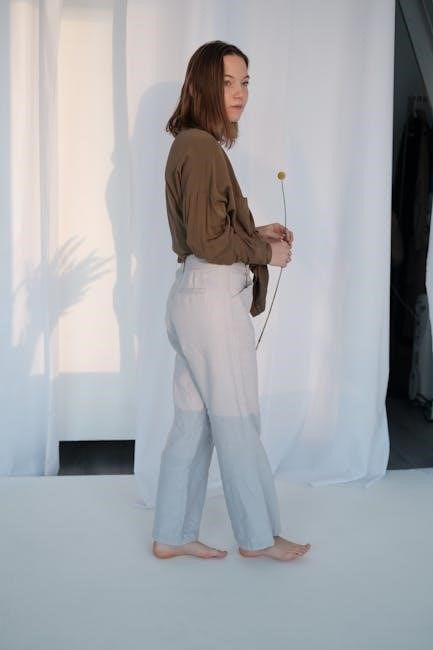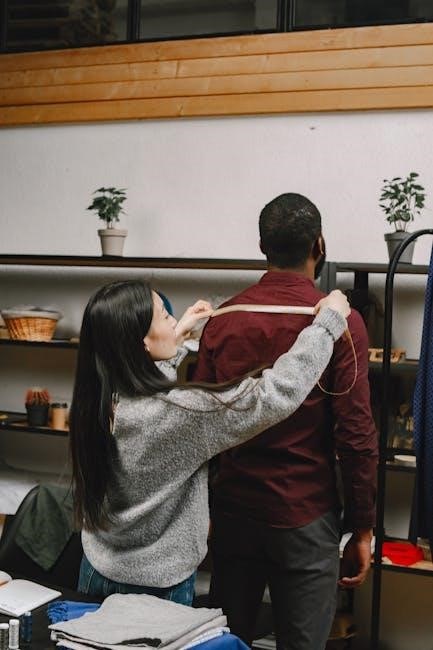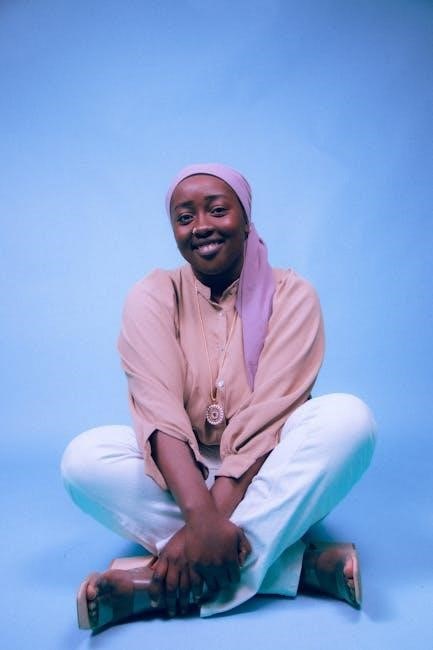A shirt length guide is essential for ensuring the perfect fit, comfort, and style. It helps determine ideal measurements for various body types, heights, and intended uses, ensuring a polished appearance.

Types of Shirts and Their Lengths
Casual shirts typically range from 29-31 inches, while dress shirts are slightly longer at 30-32 inches. Athletic shirts are shorter for a fitted, sporty look.
Casual Shirts
Casual shirts typically range from 29-31 inches in length, offering a relaxed fit. They are designed for everyday wear, often with a slightly longer hem for untucked styling. Their comfortable design suits various body types, ensuring ease of movement. These shirts are versatile, suitable for both tucked and untucked looks, making them a staple in many wardrobes. Their length allows for a balanced appearance with jeans or casual trousers.
Dress Shirts
Dress shirts generally have a length of 32-34 inches, ensuring a tailored fit. They are designed to be tucked into formal trousers, with a slightly longer back hem for a seamless look. The length accommodates various body types and heights, ensuring the shirt stays tucked during movement. Proper fit enhances professionalism, making dress shirts ideal for formal events and office attire, where a polished appearance is essential.
Athletic Shirts
Athletic shirts are designed for functionality and comfort, typically featuring a shorter length of 25-28 inches. They often have a slim fit and moisture-wicking fabric, catering to active lifestyles. The length ensures freedom of movement while maintaining coverage. These shirts are ideal for sports and casual wear, offering a practical blend of style and performance. Proper fit enhances mobility and comfort, making them a versatile choice for both workouts and everyday activities.

Measuring Shirt Length
To measure shirt length accurately, lay the shirt flat and place the measuring tape at the center back of the collar. Measure straight down to the bottom hem. This ensures a precise fit and proper appearance, whether the shirt is tucked in or left untucked.
Where to Measure
To accurately measure shirt length, start at the shoulder seam where the armhole begins. Lay the shirt flat and measure straight down to the hem at the bottom. For a precise fit, ensure the measuring tape is centered at the back of the collar and runs perpendicular to the hem. This method guarantees accurate measurements, ensuring the shirt fits well whether tucked in or worn untucked. Proper alignment is key for a balanced and stylish appearance.
Tools Needed
A flexible measuring tape is essential for accurately determining shirt length. Lay the shirt flat on a smooth surface, ensuring it is evenly spread. Place the tape at the shoulder seam and extend it straight to the hem. A ruler can also be used if a tape measure is unavailable. Ensure the fabric is smooth and wrinkle-free for precise measurements. Proper alignment guarantees accurate results, helping you choose the ideal shirt length for your needs.
Factors Influencing Ideal Shirt Length
Torso length, intended use, and fabric type are key factors. Longer shirts suit taller individuals, while shorter styles complement petite frames. Fabric drape and activity level also matter.
Body Type
Different body types require tailored shirt lengths for optimal fit. For athletic builds, slightly longer shirts balance broad shoulders. Petite frames benefit from shorter lengths to avoid overwhelming the torso. Slim individuals can opt for fitted styles, while larger body types may prefer longer shirts for coverage and proportion. Understanding your body type ensures a flattering and comfortable fit.
Height
Height plays a significant role in determining the ideal shirt length. Taller individuals may prefer longer shirts to maintain proportion and coverage, while shorter individuals benefit from shorter lengths to avoid overwhelming their frame. Measuring from the shoulder seam to the hem ensures the shirt complements the body’s proportions, creating a balanced and polished look regardless of height.
Style
Style significantly influences shirt length preferences. Casual shirts often feature a shorter, relaxed fit, while dress shirts are designed longer for tucking. Modern trends include cropped lengths for a fashionable look or longer, oversized styles for layering. The right shirt length enhances the overall aesthetic, ensuring the garment aligns with personal taste and current fashion trends, making it a key consideration for both practicality and visual appeal.

How to Choose the Right Shirt Length Based on Intended Use
For work attire, choosing the right shirt length ensures professionalism and practicality. Opt for a length that stays neatly tucked, avoiding excessive fabric. Measure accurately to ensure the shirt isn’t too short or long, maintaining a polished look. Consider body type and personal style to balance comfort and aesthetics, ensuring the shirt complements workplace norms while offering a sharp, put-together appearance.
Formal Events
For formal events, shirt length is crucial for a polished look. Ensure the shirt is long enough to tuck in seamlessly, avoiding excess fabric. Proper fit and style are key to exuding confidence and sophistication. Measure accurately to align with your body type, ensuring the shirt stays tucked and maintains a sharp appearance throughout the event.
Casual Wear
For casual wear, shirt length should offer comfort and versatility. Opt for a length that hits just above the waistband when untucked, ensuring a relaxed yet put-together look. Pair with jeans or shorts for a balanced appearance. Avoid overly long shirts that may look sloppy, and consider the fit to maintain style while allowing ease of movement for everyday activities.
Work Attire
For work attire, shirt length should be slightly longer to ensure it stays tucked in, maintaining a professional appearance. Aim for a length that reaches the mid-to-lower hip when tucked, preventing the shirt from pulling out during movement. A well-fitted shirt enhances posture and confidence, making it suitable for formal office settings or business casual environments. Proper length ensures a polished look while allowing ease of movement for comfort throughout the day.

Common Mistakes to Avoid When Determining Shirt Length
Common mistakes include incorrect measurements, not considering tucking, and ignoring body type. Proper fit ensures style and comfort, so accurate measuring and intentional choice are crucial.
Incorrect Measurements
Incorrect measurements are a common mistake when determining shirt length. Many people measure from the wrong starting point or fail to account for fabric shrinkage. To avoid this, always measure from the collar seam at the base of the neck straight down to the hem. Ensure the shirt is laid flat and smooth for accuracy. Avoid measuring over the shoulders or midsection, as this can distort the result. Proper technique guarantees the best fit and style.
Not Considering Tucking
Not considering tucking is a frequent oversight when choosing shirt length. A shirt that is too long or too short for tucking can disrupt the intended style. Longer shirts are ideal for tucking, creating a sleek, formal look, while shorter styles are designed to stay untucked for a casual appearance. Failing to account for tucking preferences can result in an ill-fitting or unflattering silhouette, emphasizing the importance of this factor in selecting the right shirt length for any occasion.
Tips for Styling Different Shirt Lengths
Layer shorter shirts over longer ones for a stylish contrast, and tuck longer shirts into pants for a polished, formal look that enhances overall balance and proportion.
Layering
Layering shirts of varying lengths adds depth to outfits. Shorter shirts can be worn over longer ones for a modern look, while tucking longer shirts into pants creates a polished appearance. This technique balances proportions and enhances style, making it versatile for both casual and formal settings. Proper layering ensures comfort and visual appeal, allowing for endless combinations to suit individual tastes and occasions.
Tucking
Tucking a shirt is a styling technique that enhances fit and appearance. For shorter shirts, partial tucking creates a relaxed look, while longer shirts can be fully tucked for a polished, formal style. Ensuring the shirt isn’t too long or too short is key for a balanced look. Tucking draws attention to the waistline and elongates the torso, making it a versatile option for both casual and formal outfits. Proper tucking ensures a neat, tailored appearance.

Shirt Length and Overall Appearance
Shirt length significantly impacts overall appearance, affecting balance and proportion. The right length enhances style, ensuring the shirt complements the body without appearing too long or short.
Balance
A well-balanced shirt length ensures the garment neither overwhelms nor underwhelms the frame. Proper balance avoids disproportion, making the shirt flattering with pants or jeans. It aligns with body proportions, creating a harmonious look. For taller individuals, longer shirts maintain symmetry, while shorter torsos benefit from shorter lengths to avoid bulkiness. Achieving balance ensures the shirt complements the overall outfit seamlessly.
Proportion
Proportion in shirt length ensures harmony between the garment and the wearer’s body. It maintains a balanced relationship between the shirt’s length, sleeve length, and the individual’s height and torso. Proper proportion prevents the shirt from appearing too long or too short, ensuring a flattering fit. For taller individuals, longer shirts maintain proportion, while shorter shirts suit those with shorter torsos, creating a cohesive and polished appearance.
Current Trends in Shirt Lengths
Modern shirt trends emphasize versatility, with cropped and oversized styles gaining popularity. Shorter lengths suit casual wear, while longer shirts are favored for layering and formal events.
Modern Trends
Modern shirt length trends lean toward versatility, catering to diverse styles and preferences. Cropped tees are popular for casual looks, offering a sleek, contemporary aesthetic. Meanwhile, longer shirts are favored for layering, creating a balanced, polished appearance. Slim-fit designs emphasize tailoring, while oversized shirts provide comfort and a relaxed vibe. These trends adapt seamlessly to formal and informal settings, ensuring a timeless yet fashionable appeal in any wardrobe.
How to Incorporate Trends
To seamlessly incorporate modern shirt length trends, pair cropped tees with high-waisted pants for a chic, casual look. For formal events, opt for longer shirts that complement tailored trousers. Layering shorter shirts under jackets creates a balanced, stylish appearance. Experiment with oversized designs for a relaxed vibe or slim-fit shirts for a refined aesthetic. Accessorizing with belts can accentuate proportions, ensuring a polished and trend-forward wardrobe.
Mastering shirt length is key to achieving comfort, style, and confidence. Whether dressing for formal events, casual outings, or athletic activities, understanding proper measurements ensures a flattering fit. By considering body type, height, and intended use, you can make informed choices. Avoid common mistakes like incorrect measurements or ignoring tucking, and embrace styling tips like layering or accessorizing. Stay trendy with modern lengths while maintaining balance and proportion for a polished appearance that elevates your wardrobe.

Leave a Reply
You must be logged in to post a comment.